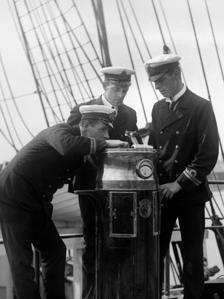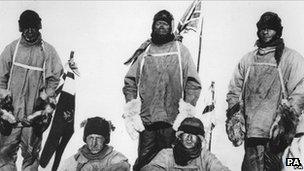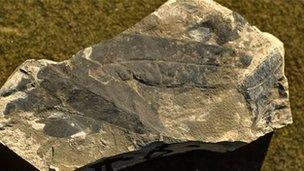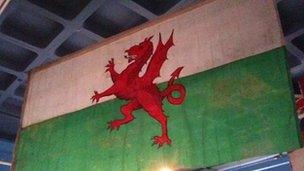Scott of Antarctic 'propaganda created Welsh obsession'
- Published

Teddy Evans (right) was a rival to Scott but his 'propaganda' won Welsh support for the adventure
For more than a century Wales has enjoyed an enduring fascination with Scott of the Antarctic.
Even before The Terra Nova departed from Cardiff in 1910, the Welsh public had already raised £2,500 towards the voyage, or about £1m in 2012 prices.
It was far more than any other region of the UK.
But the curator of a National Museum of Wales exhibition to mark the centenary of Scott reaching the South Pole, believes that the Welsh obsession with polar exploration had very little to do with the nation's pioneering spirit, or even the charismatic Robert Falcon Scott.
Tom Sharpe, Antarctic geologist and curator of the exhibition Captain Scott, South For Science, argues that Wales fell in love with the mission because of the brilliant propaganda of the Terra Nova's second-in-command, Edward (Teddy) Evans, later Lord Mountevans.
Although Evans's Welsh pedigree was dubious to say the least, he played it up to the maximum, and made full use of his connections to mount an unrivalled publicity campaign.
Mr Sharpe said: "It's debatable whether Teddy Evans had any Welsh blood at all - he was the son of a barrister from London - but that didn't matter because he was best mates with the then editor of The Western Mail, William Davies.
"The pair of them were quite brilliant at stoking up the Welsh involvement in Terra Nova, and getting people in Cardiff in particular to dig into their pockets.
"It was amazing really, as at the start the Welsh connections weren't that strong at all; although, thanks to Evans and Davies, they did become much stronger as the mission went on.

Scott (centre) dropped Teddy Evans from the final South Pole team, an act which saved Evans's life
"As well as persuading the public to donate £2,500, Evans used Davies's contacts with the mine owners to get them to donate all the coal required for the voyage.
"He then used this manufactured Welsh support, to encourage David Lloyd George as Chancellor of the Exchequer to provide a government grant of £20,000.
"While Scott was the face the public grew to love, they had very little idea that Evans was pulling the strings in Wales, or that Scott and Evans really didn't even get on, as they saw each other as rivals."
Scott would ultimately go on to have his revenge on Teddy Evans.
He waited until the polar expeditionary group was less than 150 miles from its target before he broke the news that Evans would not be part of the group of five who were to make the final assault on the South Pole.
It was a decision which would save Evans's life, because Scott and his four companions would perish on their return from the pole. Evans survived to skipper the Terra Nova home in 1913.

Scott carried this fossil, proving Antarctica was once warm, on his doomed trek from the South Pole
Even though the mission ended in failure, with Norwegian explorer Roald Amundsen beating Scott's party to the pole by five weeks, Mr Sharpe said it was still one of the biggest scientific success stories of the 20th Century.
"You have to remember that the Apollo 11 crew knew far more about what they were heading to when they went to the Moon than the Terra Nova expedition knew about Antarctica when they set out in 1910.
"What's more, Apollo 11 were in touch with base, while Scott's team were totally cut off for months at a time.
"But despite missing out on being first to the pole, they discovered things there which revolutionised our understanding of the way the planet formed.
"It might not sound a lot, but one of the most exciting discoveries was the fossil of a primitive plant called Glossopteris, which is also found in South Africa, South America and Australia."
"This one tiny piece of rock taught us firstly that the four continents were joined together at one stage, and secondly that the climate in Antarctica must once have been warm enough to sustain life."

The Welsh flag Scott planted in the Antarctic ice is part of the National Museum of Wales exhibition
"Scott didn't know any of this, but he believed that the rock samples were so valuable that he carried on dragging them with him, even as the group were dying in March 1912."
As well as the fossils Scott collected, the exhibition also features a stuffed emperor penguin, watercolours of the ice-scape by Edward Wilson, and photographs from the pole taken by Herbert Ponting.
Visitors will also be able to see the Welsh flag Scott planted in the Antarctic ice on St David's Day 1911 on his doomed return journey, in recognition of Wales' unrivalled support.
Sadly, though, the flag has seen better days, as on the return voyage well-wishers in New Zealand were allowed to cut off slivers of the cloth as mementoes.
The exhibition opens at National Museum of Wales, Cardiff, on Saturday 14 January and will run until 13 May 2012.
- Published6 January 2011